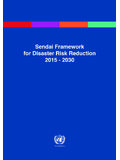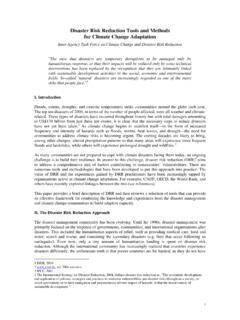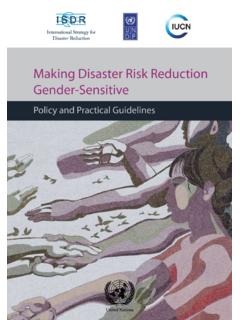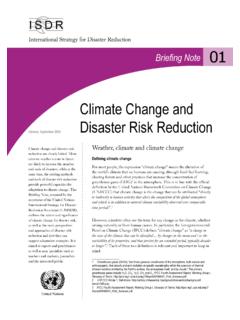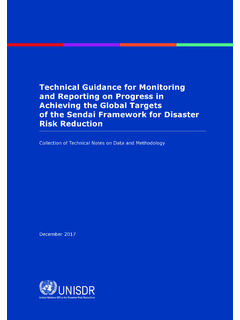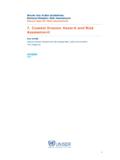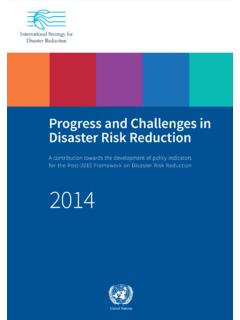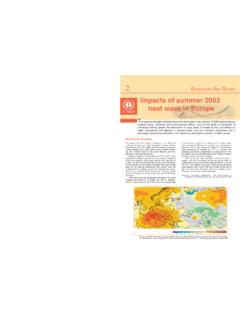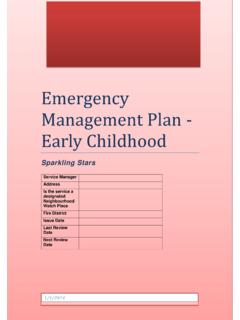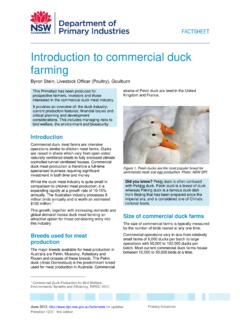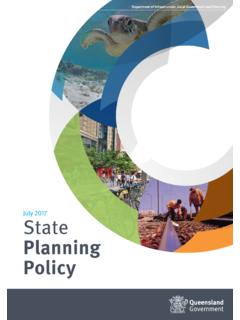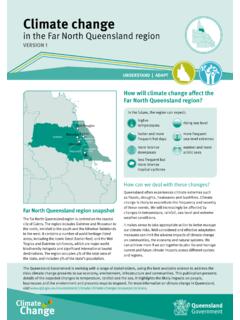Transcription of Wildfire Prevention in Australia - Home | UNDRR
1 Wildfire Prevention in Australia Australian Wildfires (Bushfires) bushfire Disasters Wildfires, or bushfires as they are commonly known in Most bushfires are not disasters, however, if not quickly Australia , are a naturally occurring phenomenon in the detected and contained, even small fires can get out of Australian environment. Before the arrival of humans on control and result in a disaster. Thankfully, few bushfires the Australian continent, bushfires were often started as earn the title of disaster', but repeated disastrous a result of lightning strikes or volcanic eruption. While bushfires near the capital city in the states of Tasmania, lightning still continues to provide the spark for bushfires, South Australia , Victoria, New South Wales and Western the actions of people (either deliberate or accidental) Australia have occurred, in which many people have lost also contribute to the many bushfires that occur in their lives, or their homes and property.
2 Australia each year. The worst of these were: Every year, especially in summer, Australia experiences a large number of bushfires that occur as either grass fires' or forest fires'. Grass fires occur mainly on grazing, Victoria (1939) 71 dead farming or remote scrub land country. Although these fires often destroy fences, livestock and some buildings, Southern Tasmania (1967) 62 dead the nature of the country and its usage, generally mean that heavy losses (particularly human life) are rarely New South Wales (1968) 14 dead experienced. Southern Victoria (1969) 23 dead Forest fires on the other hand often destroy a greater number of homes that border bushland areas, resulting South Australia /Victoria (1983) 76 dead in larger losses of human life and property.
3 Australia 's most devastating bushfires have happened where they have raged through the dense eucalypt forests in the southeast of the continent. Australian Bushfires Case Studies South Australia and Victoria Ash Wednesday', 1983. Conditions for Disaster - On 16 February 1983, Melbourne was experiencing a very hot, dry day. The temperature peaked at 43 C with relative humidity of only 6%. Drought conditions had persisted in south-eastern Australia for several years with 1982/83 summer being extremely hot and dry. Many small to moderate bushfires occurred in South Australia and Victoria over this period. Fires burned over 100,000 hectares near the New South Wales/.
4 Victoria border on 1 February. On 6 February, 95 fires were reported as they flared in hot, strong, north-westerly winds. By 16 February- Ash Wednesday', South Australia and Victoria were tinder dry and fuel loads in forests were very high. The Toll In the twenty-four hours following that morning, a holocaust of bushfires erupted, and in just a few days, burnt over 520,000 hectares across the two States. More than 3,700 buildings were destroyed, including 1. 84 commercial, and about 1,000 farms. A total of over 2,400 families or individuals lost their homes while 76. people died! Many of the total 1,100 injured people required hospital treatment.
5 Livestock losses were very high, with over 340,000 sheep and 18,000 cattle, either dead or having to be destroyed, while 20,000 km of fencing and million hay bales were burnt. During that summer of 1982/83, at least 1 million hectares were burnt out across South Australia and Victoria. Insurance losses exceeded $320 million and total estimated costs were $950 million in 1997 values. New South Wales Eastern Seaboard, 1994. Relentless Westerlies - In early January 1994, hot, dry, westerly winds began to blow from the inland affecting most of the east coast of the State. Several large bushfires broke out in the north. These were soon followed by serious outbreaks all along the coast extending to the south of Batemans Bay.
6 Dangerous winds persisted for about three weeks resulting in over 800 bushfires. The most serious fires were in the Hunter, Blue Mountains and Sydney regions. About 20,000 volunteer fire- fighters (including reinforcements from all states and territories) battled the flames and helped evacuate over 25,000 people from areas under serious threat. Losses and Costs - About 800,000 hectares burnt, including sections of Sydney suburbs and 40 National Parks. Four deaths (including 3 fire-fighters) resulted, 120 people were injured and 800 people were left homeless after 205 homes and about 20 other buildings were destroyed. Only 200 livestock died but 600 km of fencing and thousands of native animals perished.
7 Insurance losses were $56 million with total costs estimated at $165 million (1997 values). Mornington Peninsula and Dandenong Ranges-Victoria, 1997. Heatwave Conditions - Temperatures soared above 40 C as northerly winds gusted to 70 km per hour contributing to two damaging bushfires near Melbourne between 19 and 21 January 1997. At Mt Eliza two homes burnt and evacuations were required at Mt Martha and Arthur's Seat, also on the Mornington Peninsula. 250 bushfires burnt areas of Victoria on 21 January, a C. day! Worst-affected were Ferny Creek, Upwey and Kalorama settlements in the Dandenong Ranges where it took 1,500 fire-fighters and 6.
8 Water-bombing aircraft to control the 3,700 ha forest blaze. The Toll - Apart from Mt Eliza, another 41 houses were destroyed and 45 damaged in the Dandenongs. Tragically, three people died (at Ferny Creek) and about 40 were injured throughout the State. Insurance losses were about $10 million with total estimated costs of $40. million (1997 values). 2. bushfire Prevention Strategies The raw materials for any potential bushfire are the presence of fuel such as grass, leaves and twigs, oxygen from the surrounding air, and heat or direct flame. Once a fire is started with these raw materials, the spread of the bushfire depends on a number of environmental factors including: the type and size of the fuel, the fuel's moisture content and its degree of compaction, the weather, and Australia 's approach to bushfire Prevention centres on lessening the possibility of a fire occurring and minimising the spread of bushfires.
9 Fire Prevention strategies fall into the following four main categories. Land Management Residents in these areas too are required to undertake similar land management strategies, which includes Land management strategies are effective in: removing as much fuel as possible from around their house or property and the creation of suitable firebreaks lessening the presence of fuels in forests or particularly for properties that are situated next to grassland area; bushland. slowing down and sometimes ceasing the spread of bushfires; and providing easier access routes for firefighters to Building Management reach and extinguish fires.
10 The findings following the Ash Wednesday' fires showed Fuel reduction is paramount to bushfire minimisation. that the sparks and embers emitted from the fires were By taking away the fuel, fires cannot start, nor can they what caused houses to catch fire. As such, building continue to spread 2. One of Australia 's strategies to guidelines and standards are now being developed that reduce the build-up of fuels in forest and grassland areas are specifically aimed at making buildings more resistant involves the deliberate burning off of these fuels by to these fire emissions. various fire and land management agencies. In some communities, local government authorities have Not only do these fuel reduction burns' 3 lessen the regulations controlling home siting, design and the use potential for future fires in these areas (especially during of building materials in bushfire prone areas.)
